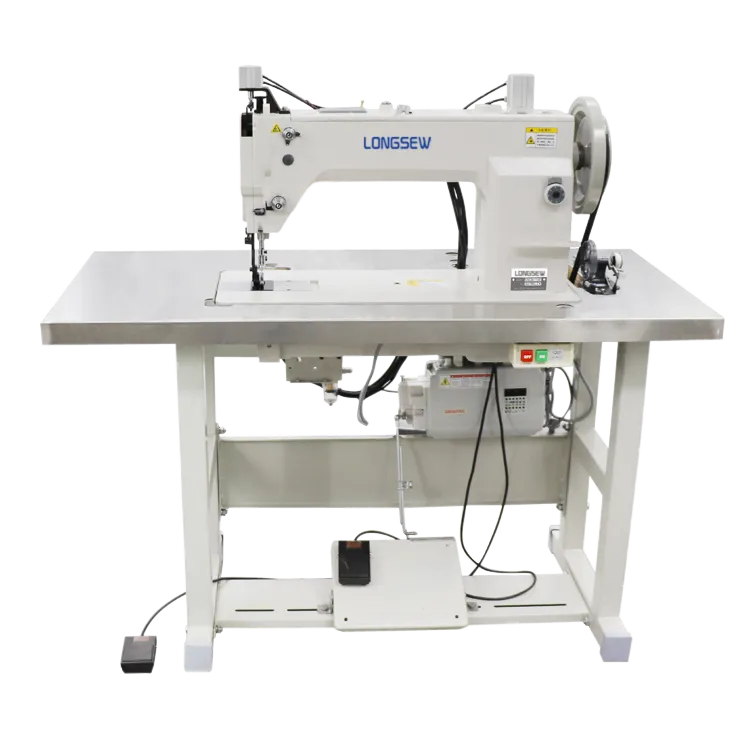what is compound feed sewing machine
Understanding Compound Feed Sewing Machines
In the world of sewing technology, compound feed sewing machines play a crucial role in enhancing productivity and efficiency. These machines are specifically engineered to handle a variety of fabrics, making them a popular choice in the garment and textile industry. This article delves into what compound feed sewing machines are, how they work, and their applications.
What is a Compound Feed Sewing Machine?
A compound feed sewing machine combines three feeding mechanisms the needle feed, the walking foot, and the presser foot. This unique combination allows the machine to feed the fabric from multiple points, ensuring a more even and consistent stitch. This is particularly beneficial when working with layers of fabric or materials that tend to shift during sewing, such as leather, vinyl, and other difficult textiles.
The needle feed mechanism allows the needle to move the fabric down as it penetrates, while the walking foot synchronizes the upper layer of fabric. Together with the presser foot, which keeps the fabric in place, these features work in harmony to produce high-quality seams with minimal puckering or distortion.
How Does a Compound Feed Sewing Machine Work?
The operation of a compound feed sewing machine is based on the synchronization of its various feed components. When the machine is in use, the needle moves up and down, creating stitches while simultaneously pulling the fabric through the machine. The walking foot moves in a coordinated manner with the needle, guiding the fabric as it is fed into the needle area. This multi-point feeding system not only ensures that the fabric is fed evenly but also helps to prevent slippage, which is crucial for achieving precise seams.
Another notable feature of compound feed machines is their ability to handle heavy materials. The compound feeding mechanism allows these machines to work with thicker fabrics like canvas, leather, and upholstery material — tasks that would be challenging for conventional sewing machines.
Applications of Compound Feed Sewing Machines
Compound feed sewing machines are widely used across various sectors. Some of the primary applications include
1. Apparel Manufacturing These machines excel in sewing garments, particularly those that involve multiple layers, such as jackets and coats. Their ability to handle heavy fabrics makes them ideal for outerwear.
what is compound feed sewing machine

2. Upholstery In the furniture industry, compound feed machines are commonly used to sew upholstery fabrics for sofas, chairs, and other furniture items. The machine’s ability to manage thick materials ensures durability and quality in the final product.
3. Leather Goods Production The leather industry relies heavily on compound feed machines for creating bags, shoes, and belts. The robust feeding system enables precise stitching, which is pivotal for high-end leather products.
4. Industrial Applications These machines are also utilized in various industrial settings, including the production of tarpaulins, tents, and other heavy-duty sewn products.
Advantages of Using Compound Feed Sewing Machines
The advantages of using compound feed sewing machines are numerous
- Enhanced Precision The synchronized feeding mechanisms result in more accurate stitching, reducing the risk of fabric distortions.
- Versatility The ability to handle a wide range of materials makes these machines suitable for diverse applications.
- Increased Speed Compound feed machines often operate at higher speeds than standard machines, significantly boosting production rates.
- Durability Designed to accommodate heavy-duty sewing tasks, these machines typically have robust construction, ensuring longevity and reliability.
Conclusion
In summary, compound feed sewing machines are an essential asset in the sewing industry, offering superior feeding capabilities that lead to high-quality seams and enhanced efficiency. Their versatility and effectiveness make them invaluable for a range of applications, from apparel manufacturing to heavy-duty textiles. As the demand for diverse fabric handling continues to grow, the significance of compound feed sewing machines in modern sewing practices will undoubtedly increase.
-
Industrial Cylinder Arm Sewing Machine: Revolutionizing Heavy-Duty SewingNewsJul.28,2025
-
Cylinder Arm Sewing Machine: Perfect for Special Sewing ApplicationsNewsJul.28,2025
-
Cylinder Bed Sewing Machine: Essential for Sewing Complex MaterialsNewsJul.28,2025
-
Heavy Duty Sewing Machine: The Essential Tool for Industrial ApplicationsNewsJul.28,2025
-
Computerized Pattern Sewing Machine: Revolutionizing Precision StitchingNewsJul.28,2025
-
Heavy Duty Industrial Sewing Machine: Power Meets PrecisionNewsJul.28,2025
-
Leather Sewing Machine: The Industrial Standard for Tough MaterialsNewsJul.18,2025





























